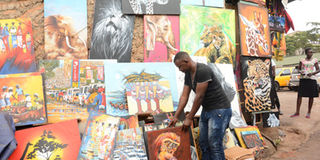Tapping into rich African art, culture and heritage

A trader displays African art paintings at his crafts shop last year . FILE PHOTO
What you need to know:
- Awori advises that when thinking of designing an African interior, the design and the functionality matters. She asks if one is simply looking for a theme or they also care about the usability and ergonomics of the design chosen.
African culture is rich and diverse. It is beautiful too. Making it part of your living spaces is worthwhile for the reflection of your heritage as well as style, taste and personality. Hospitality facilities are taking the lead in this with lots of wall hangings and art pieces reflecting different components of culture.
From Kampala Serena Hotel to Latitude 0 Degrees Hotel, Emin Pasha, Mestil Hotel, a number hotels, restaurants and lodges are delicately keeping the old in place, giving the curious patrons something to learn and ultimately admire from the artefacts that tell Ugandan and continental stories and those of explorers and their influence on the African heritage.
“Curated original artworks form huge centre pieces in lobbies, ornate hand beaded textiles adorn the stylish bedrooms and our funky recycled and upcycled furniture really pushes the boundaries of local artisans’ talent, and the materials they have to hand,” a statement from Latitude, reads, in part.
Through travels, you can collect a number of items. From the perspective of African art and culture. Interior designer and artist Sheila Nakitende, explains that there is a lot of resource ranging from colour, materials and patterns that can be adopted while working to decorate a space.
Interior designer Joanne Awori cautions that it is very common when designing an African theme for people to be biased towards the common deep browns, reds and oranges.

You can hang paintings and pictures that depict African culture in your living room. Photo by Rachel Mabala
Africa has wider palette than that and she tips that it is time that we define that palette to go wider than the earthy and restrictive tones. Fellow interior designer, Phillip Luwemba, says African artistes have done a good job of colourfully and creatively capturing different aspects of Africa, for example culture and telling stories of people who lived with wild animals.
“When a space is inspired by culture, it is normally themed. If you are a lover of animals like zebras, lions, you can start from the skin colour and create an animal print.
You can use an aspect of animals, for instance a mask that can be made out of wood or dried skin bought from hunters to capture African decent,” Luwemba explains.
There is also an aspect of evolution in art and culture whereby through modern design one can adopt traditional African handmade objects, materials and colours to decorate a space.
The art and culture includes painting, sculpture, masks, baskets, wall hangings.
She adds that use of natural materials such as bamboo, reeds, the colour pallet and patterns such as those used in weaving are a bed of ideas to select from for modern African decor.
Tadeo Kasirisimbi, an artist, and a colleague, were commissioned by Mestil to create and craft sculptural representation of African culture for use in particular parts of the hotel.
“We opted to illustrate culture through inspiration from some of our historic communal activities such as hunting, omweso (board game) and singing. Undertaking the project gave value and purpose to our work. While decorating or complimenting the space/ corridors of the hotel,” she explains their cultural, artistic venture.
Depicting activities
Luwemba says African culture can also be showcased in activities such as singing, dress code, cooking dancing which can be captured in paintings. Carpentry workshops and craft villages are a good place to find some of these items.
These silhouette works show women and men hunting, fetching firewood and water that can be hanged within homes.
Luwemba says that home owners should be mindful of how they blend colours in the art pieces and the furniture in the different rooms.
“Photography and photojournalism are crucial in portraying culture in the countryside where some of the norms are still active, for example people engaged in cultural activities for example at traditional weddings, kings. A stoic Muganda or Mutooro will hang a photograph of their kings in their living room.”
Awori advises that when thinking of designing an African interior, the design and the functionality matters. She asks if one is simply looking for a theme or they also care about the usability and ergonomics of the design chosen.

African sculpture art makes for beautiful decor. Global Atlanta photo
What to consider
She explains: “When designing our homes, it very easy to trap ourselves into one theme such as for instance an African Safari or African Crafts theme. One must be careful with this approach, if not done with functionality in mind, one can easily tire of the space.”
Awori also tips that you keep it light by picking and choosing your accessories carefully. Plus, consider incorporating African modern/contemporary photography and art over heavy use of masks and bulky statues and crafts.
Luwemba says there is variety of artefacts such as baskets, pots, mats, calabash, sculpture and masks in the market. One can get them from craft shops or vendors.
“We have many wild animals, farming activities, drinking around fires, weddings, burials and more. Right now, I am working in an interior concept of a restaurant and we would like tables in form of drums so that when you enter the space, your mind thinks of culture,” he adds.
Well, like Jamaican orator and journalist, Marcus Garvey would have it, a people without the knowledge of their past history, origin and culture is like a tree without roots.




